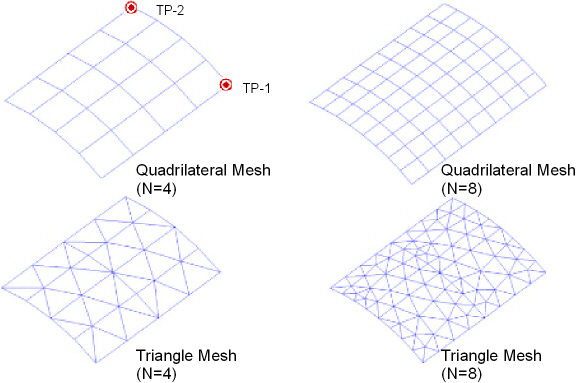Benchmark C3
VMC3
Barrel Vault Roof Under Self Weight
Overview
Test Case
A cylindrical shell roof is subjected to gravity loading. The roof is supported by walls at each end and is free along the sides. Monitor the y displacement and bottom axial stress (σz) at target point 1, along with the bottom circumferential stress (σθ) at target point 2 for a series of test cases with increasing mesh refinement using quadrilateral and triangular element shapes. A companion problem that studies irregular element shapes is VMD2.
| Material Properties | Geometric Properties | Loading and Boundary Conditions | |||||||||||||
|---|---|---|---|---|---|---|---|---|---|---|---|---|---|---|---|
|
|
|
Target Solution
Target solution is obtained from an 8-node quadrilateral shell
element solution with N=8, (see
R. D. Cook, Concepts and Applications of
Finite Element Analysis).
| ETYP | N | DOF | UY(1), m | σz (1), Bottom | σθ (2), Bottom |
|---|---|---|---|---|---|
| -- | 8 | 2310 | 3016 | 358,420 | -213,400 |
| Ratio | |||||
|---|---|---|---|---|---|
| ETYP | N | DOF | UY(1) | σz (1), Bottom | σθ (2), Bottom |
| Results Comparison - Quadrilateral Elements | |||||
| 281 | 4 | 390 | 1.004 | 0.9536 | 1.027 |
| 281 | 8 | 1350 | 1.000 | 1.000 | 1.002 |
| 181 | 4 | 150 | 1.048 | 0.940 | 0.983 |
| 181 | 8 | 486 | 1.008 | 0.999 | 0.985 |
| Results Comparison - Triangular Elements | |||||
| 281 | 4 | 774 | 0.971 | 0.953 | 0.980 |
| 281 | 8 | 2022 | 0.992 | 0.971 | 0.996 |
| 181 | 4 | 222 | 0.762 | 0.507 | 0.722 |
| 181 | 8 | 558 | 0.903 | 0.632 | 0.888 |
Assumptions, Modeling Notes, and Solution Comments
The problem is designed to test singly-curved shell elements under membrane and bending deformation. The quadrilateral mesh patterns produce uniform rectangular shapes while the triangle mesh patterns are as generated by the meshing algorithm in the solid modeler.
Results for SHELL181 in triangular form are presented, though they are not recommended for use. SHELL181 is based on a hybrid formulation for a quadrilateral element shape. Hence, degeneration of the element to a triangular shape will show some slight node-ordering dependence on the element solution.
The target solution is obtained in the prescribed reference for the author's 8-node shell element.
As expected, the quadratic SHELL281 performs better than the linear element SHELL181 for comparable meshes.
Results for the linear triangular-shaped elements is poor due to the constant-strain membrane behavior within the element. The effect of constant-strain membrane behavior is to overly stiffen the element under this type of loading, hence underpredicting both displacement and stresses. For triangular elements, only a fine mesh using the quadratic SHELL281 elements produces acceptable results.



